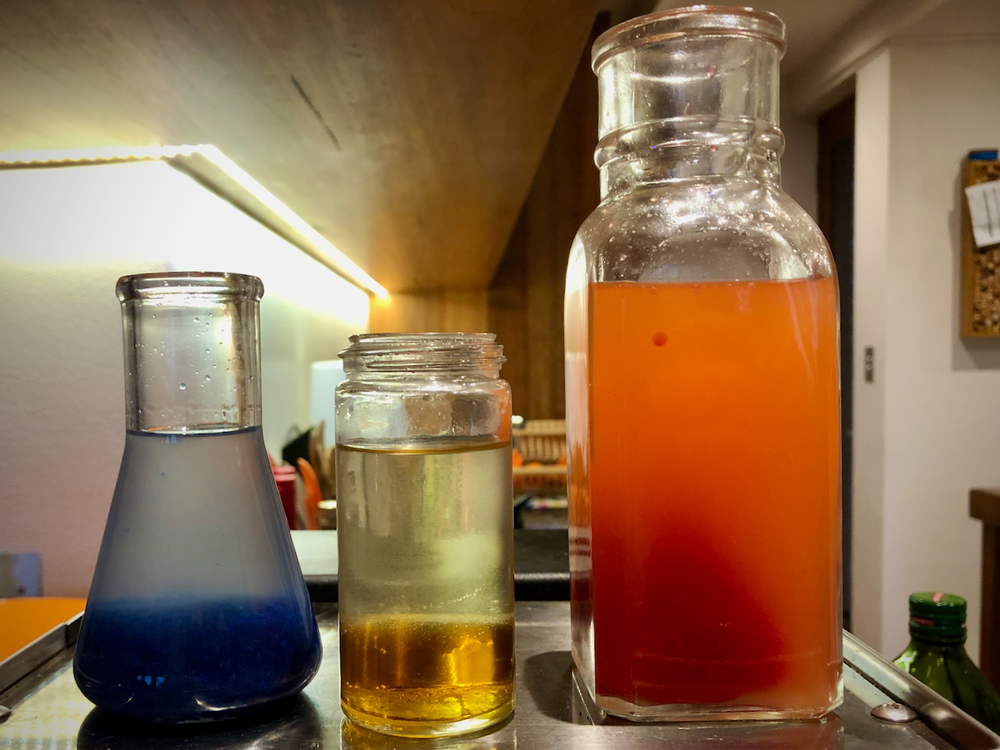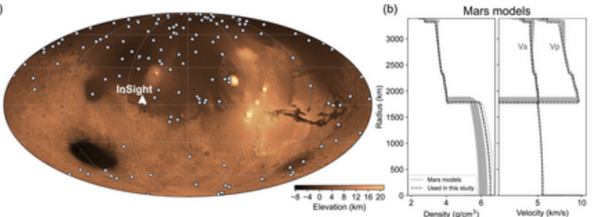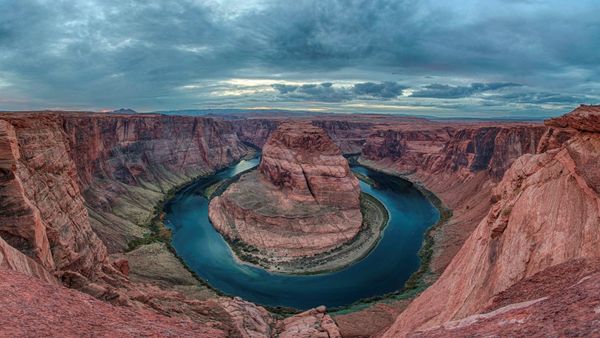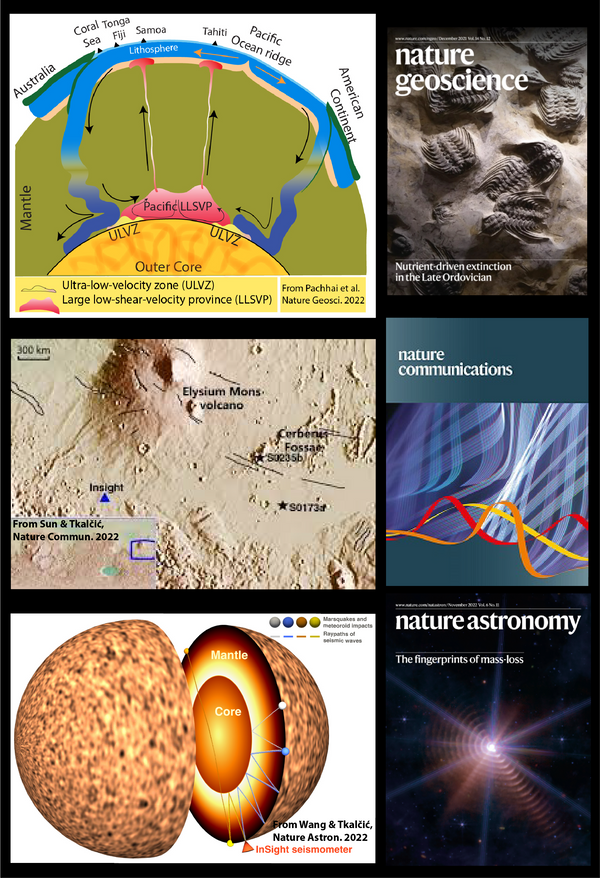Lava Lamps & Thermochemical Convection
In the 1960s, the mesmerising, dancing fluids of the ubiquitous Astro Lamp (better known as the Lava Lamp) symbolised a future of endless peace and prosperity when everyone would live the glamorous life of the international jet set. While we wait for that future to arrive, the Lava Lamp serves as a distraction for the stresses of everyday life and, for physicists, a beautiful demonstration of the chaotic dynamics of convecting systems.
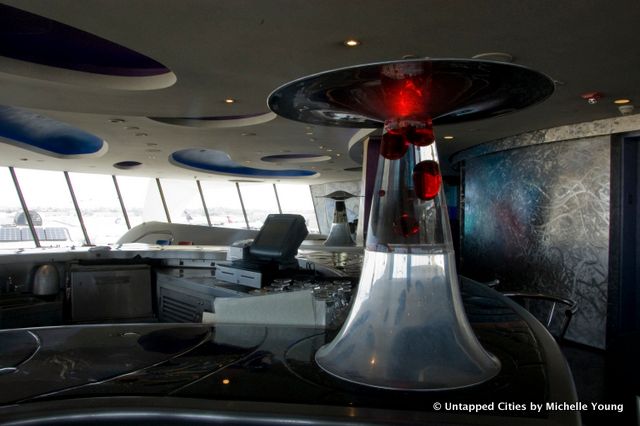
The Earth's continental and oceanic regions respond in fundamentally different ways to convective overturn of the underlying mantle. The oceanic lithosphere is very obviously part of the convecting system, recycled into the interior after a hundred million years or so while the continental lithosphere is definitely not part of this circulation. This stands out in the dichotomy in the age distribution (oceans are all relatively young, continents don't have to be and can be very, very old). The main reason for this difference is the buoyancy of continental crust that prevents it from being recycled en masse by mantle convection.

We have just described a form of thermochemical convection: a system in which compositional and thermal buoyancy compete with each other. Convection can be driven or enhanced by the compositional density difference (e.g. the primary driving mechanism for convection in the Earth's outer core is the release of lighter fluid by crystalisation of the inner core) or it can be opposed by the inherent buoyancy associated with compositional variations which is the situation for the continental crust. This crust is negatively buoyant thermally (it's cold) but positively buoyant because it is an immiscible, light material with respect to mantle rocks. The D'' layer is the mirror image of this situation; Located at the core-mantle boundary is a compositionally dense, hotter material that may help to orchestrate the pattern of mantle plumes but, at the same time, is isolated from the global circulation.
This is all very complicated, but we can learn a lot with some simple analogue experiments. What we are going to do is give you a recipe for building a lava lamp in your kitchen which, if whether you succeed or not, will give you ninja skills in thermochemical convection and the ability to understand why the continents are so long lived.
Recipe
You can find many lava lamp recipes online but we are going to steer you in the direction of a safe-but-interesting one. It's a bit rough and ready and won't last for all that long but it does work. You will need:
- Cooking oil (This will be the lava. You can choose something with a striking colour like olive oil or try to colour it yourself later)
- Rubbing alcohol (isopropanol 60% mix in water)
- Glassware such as a pyrex jug, a jam jar or a clear glass bottle that can be heated without cracking.
The rubbing alcohol is lighter than cooking oil and the two are immiscible. If you pour some of each into a glass jar (20% oil, 80% isopropanol solution), you have the makings of a lava lamp. If you add some water, it will mix with the isopropanol and make it a little more dense. With this trick you can fine tune the density difference between the two fluids and you will immediately see that the blobs of oil settle more slowly when the densities are comparable. Go too far and you will find the oil switches places to float on top as it does with pure water.
First of all, we should try heating up this prototype lava lamp. The rubbing alcohol solution is potentially flammable so be careful ! You can use a large frying pan over a low heat to make sure the jar is not overheated. If that still seems to be too hot, put water in the pan, a plate in the water, and the jar on top of that. This will also avoid problems if the contents spill out.
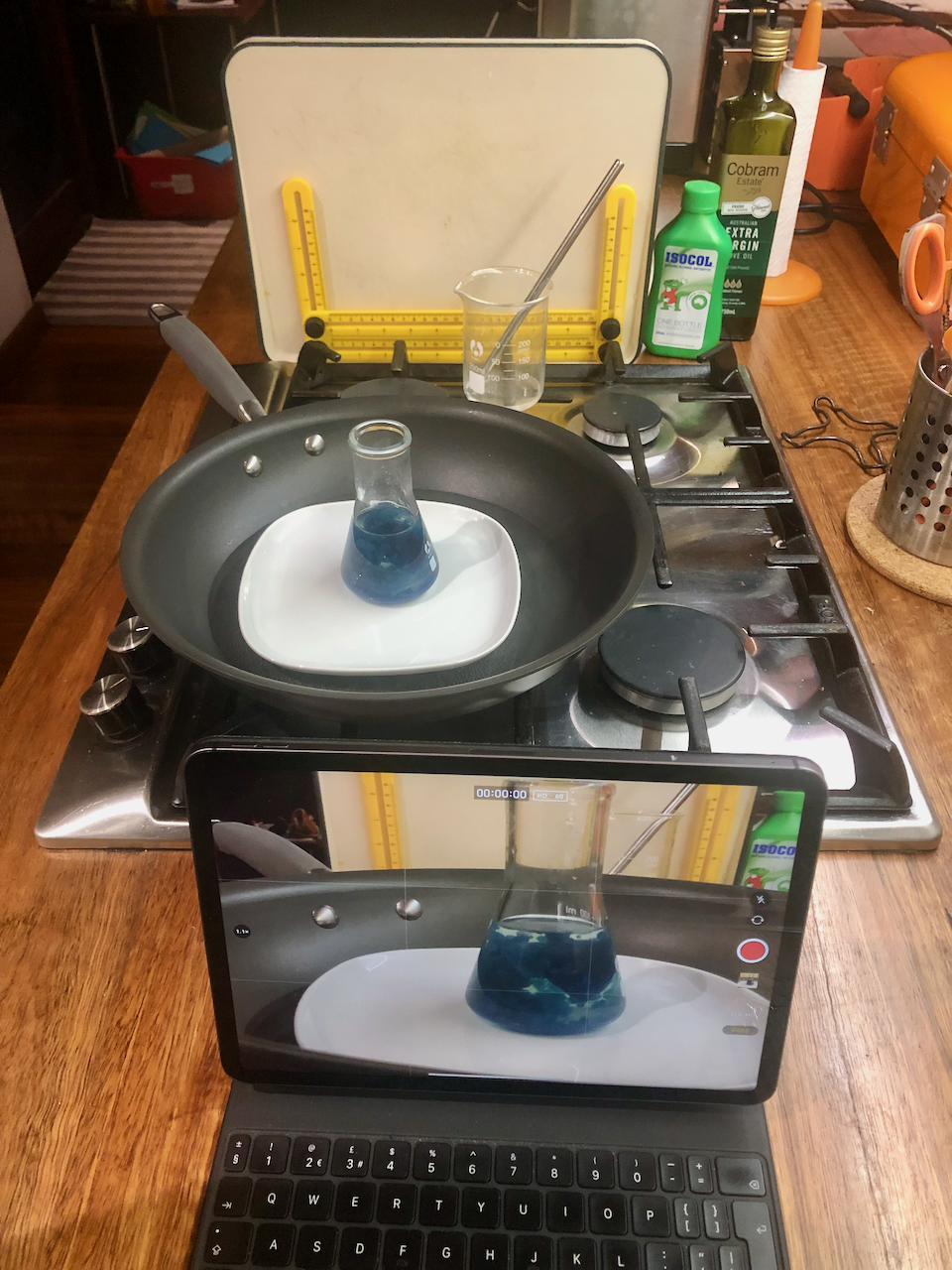
You may find that you have a lava lamp, but a more likely outcome is that the two layers remain layered. You can add a little water (a drop at a time, then wait till it is mixed and warmed up to see what difference it makes).
At some point, you will see that heat transfer by convection is enough to stir up the oil from the bottom of the container and keep it aloft until it cools enough to sink.
That's it. You are getting a feel for the competition between the different forms of buoyancy and you can start your own experiments.
Videos
Here are some of our movies. Read the FAQ section below for some tips and tricks on how to make things more interesting.
Starting from cold, watch a whole collection of lava lamps trying to get going.
At some point, thermal equilibrium is reached a steady state in which the heat transfer on average is not changing but, of course, there is plenty of time-dependent behaviour.
We can simply leave this experiment running and see what happens. This is a close up of the green/yellow flask lava where you can see the internal dynamics of the blobs as they form. Watch this one at double speed !
And here the lava amoeba gets ready to leap out of the flask and destroy the world.
FAQ
Here are some tips and tricks for going past the basics.
My lava lamp is upside down ! Did you add a bit too much water to the alcohol layer ? You can try to reverse this by removing some of the alcohol layer and starting again. But you can also try heating it up and see what happens. The thermal expansivity of the oil / alcohol layers are not the same and you may find that they switch over when hot. The mathematics of the lava lamp works regardless of which way up you start (some small assumptions) so it should still work (watch the black lava lamp in the movies).
It's all cloudy and the blobs are too small ! It may be helpful to add a little bit of salt which dissolves in the water / alcohol solution and may make it less favorable for the oil to mix in. A very small amount of detergent can help adjust the surface tension but don't add too much or everything will become one horrible slurry.
There is just one big blog flopping about in the jar and doesn't have the proper relaxing effect (in fact it's making me stressed). There are many options to help you de-stress, yoga perhaps, or beer. You can also add a small washer or spring to the container (like a real lava lamp) and this will break up the blobs a bit.
I turned up the heat and it's starting to boil. Is that OK ? Be careful if the alcohol mixture starts to boil as you don't want to inhale nasty fumes or start a fire. Turn down the heat or try the tip where you heat indirectly using a plate in a bath of water. See the theory section, you can get the same effect as higher temperatures if you reduce the density drop between the two fluids or change the depth of the layers. It's more complicated for the thermochemical case but try it anyway !
How do you make coloured lava ? In these examples, you can see the results of using common items from around the house: black shoe polish (the black / clear lava lamp), wax crayons (the blue one and the red one: it obviously has some solid glittery ingredients that sometimes form a heavier sub-layer. Quite cool, actually), candles from a birthday cake (the greenish yellow one: the candles were coloured but by some sort of paint that did not mix in and the wax is far from clear. It did not look promising at first but is quite a pretty one). White board markers (the blue-green one: the blue of the marker is soluble in the alcohol so this is not coloured lava as such).
I made coloured lava but the colour leaked out into the whole lamp. Do I need to throw it away ? Not necessarily. One thing to do is to wash the coloured lava with water to remove water- (alcohol-) soluble dyes. Then pour off the lava from the water, wash it again, and then go back to make the lava lamp.
Can I pour this down the sink ? You'd better check with your local authority. If you mix everything with detergent and dilute it, the result is relatively benign but not altogether harmless.
Theory
The first-order picture of Earth's convecting mantle and plate-tectonic system is an isoviscous, Rayleigh-Bénard, overturning layer which can be characterised by a single Rayleigh number (which measures the vigour of convective motion):
$$Ra = \frac{g \rho \alpha \Delta T d^3}{\kappa \eta}$$
Low Rayleigh number means slow convection and large, ponderous blobs, high Rayleigh number is more lively and smaller blobs move quickly around the container.
This comes from a simple model that does a very good job of explaining how the thickness and heat flow (and hence depth) in the oceanic lithosphere varies with age (see Turcotte & Oxburgh, 1972)
Corresponding to this thermal Rayleigh number is an equivalent one that accounts for the buoyancy difference between materials with different composition. Here we assume that there is a compositional field analogous to temperature with 0 and 1 representing the two end-member compositions (e.g. van Keken et al, 1992).
$$ Ra_C = \frac{\Delta \rho g d^3}{\kappa \eta}$$
We will also assume that the composition does not diffuse (hence the thermal diffusivity provides the timescale) which is a very reasonable assumption for the large-scale examples of our whole-Earth model.
The lava lamp consists of two immiscible liquids of different density (and contrasting colour) in a clear bottle and an incandescent bulb as a heat source. The density of the two fluids is close enough that heating the denser one by a few degrees is enough to make it lighter than the other. The competition between composition and temperature results in the chaotic and unpredictable behaviour over time and the relaxing effect. The viscosity of the lava (heavier) component of the lamp is important (aesthetically) because it determines the size and speed of the rising drips that form in the lamp.
References
van Keken, P. E., King, S. D., Schmeling, H., Christensen, U. R., Neumeister, D., & Doin, M.-P. (1997). A comparison of methods for the modeling of thermochemical convection. Journal of Geophysical Research: Solid Earth, 102(B10), 22477–22495. https://doi.org/10/cpbp8c
Turcotte, D. L., & Oxburgh, E. R. (1972). Mantle Convection and the New Global Tectonics. Annual Review of Fluid Mechanics, 4(1), 33–66. https://doi.org/10/cqqwpt
Acknowledgements
This experiment was developed as part of the Monash University Astrophysics Honours program and we owe a great debt to the students who tried every imaginable combination of ingredients to find a safe recipe by eliminating all the scary ones. We presented that work at the Fall Meeting of the AGU in 2005. This is the poster.
